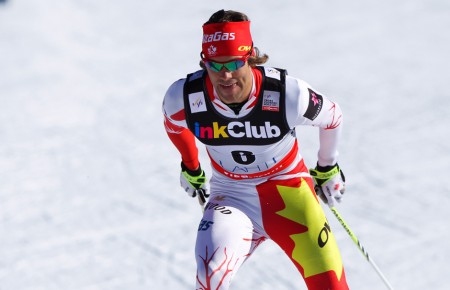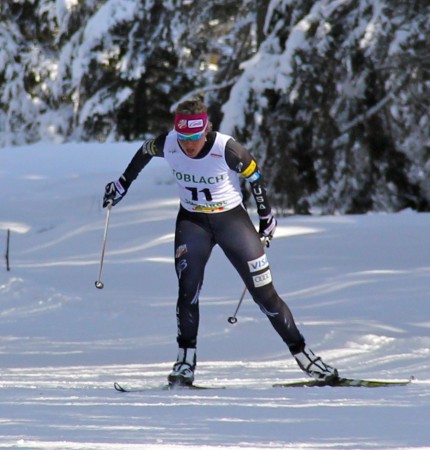Only days remain in the 2013 World Cup and there’s less than a month to go before SuperTour Finals and Canadian Nationals wrap up the competitive season for North Americans. For this edition of our workout series we mixed things up a bit and asked a few national team athletes how they orchestrate an end-of-year taper, and how their peaking plan for World Championships in February affected the racing that followed and is still to come.

Lenny Valjas was eighth in the Lahti, Finland, classic sprint last week after being sick for World Championships. In general he tries to keep his training relatively consistent throughout the year, and particularly during back-to-back racing at the end of the World Cup season he doesn’t feel he needs to add much to his plan in the way of hard efforts — races are the intervals.
“During the race season I ski around an hour to an hour and a half a day, and that’s pretty much all I do and different types of workouts,” he said after placing 16th in the Drammen city sprints last week.
“Right now I would just be going race to race because the races are pretty close together between Lahti and Drammen. I ski easy and then the race prep, do some intensity a few days before the race. It’s pretty simple, I’m just trying not to get too tired or burnt out here. There’s been a lot of racing this year; I haven’t missed a race weekend yet. I’m just trying to finish it off.”
Overall, Valjas thinks his season has turned out pretty well so far with this approach. He finished 23rd in the Tour di Ski, which included a second-place finish in the 15 k classic, and has peppered consistent top-20s with a few top-10s in the months since to be ranked 20th overall going into World Cup Finals. And since he had to skip World Championships after getting sick in Italy, Valjas thinks he may still be peaking for these last few races.
“This year’s worked out pretty well,” he said. “I had a good Tour then I took a bit of a break after that so I didn’t overdo it too much. I’ve felt pretty consistent this year, I’m happy with how the season went. Worlds, because I was sick… I know I’m in good shape still. I didn’t get tired at worlds because I only did two races. I think my shape now is still good. I’m thinking that I’m still somewhat peaking from worlds. My shape is still there so I want to bring that into the spring here and see if I can get some more results.”

Sadie Bjornsen has experienced a late run of career bests with a ninth and 18th in Lahti, Finland and a 30th in Drammen, Norway. She approaches her taper periods much like Valjas does; by treating races as intensity workouts and minimizing the volume in between. She cut her workouts down to once a day and eliminated strength prior to World Championships. Post-Val di Fiemme she added strenth back into her routine and slightly increased the volume again to maintain her fitness through the end of the season.
“I kind of go by the rule that I cut down to one workout and then every workout has a super-focused point,” Bjornsen said of her pre-World Championships approach. “If you want to do speed then you’re only doing speed and you’re only out there for an hour.”
Three days out from a race she would do speeds, two days prior she’d vary hard efforts between 10 seconds and a minute, and the day before Bjornsen would ski one harder effort, all while keeping total on-snow time below an hour each day.
During a full-on taper period Bjornsen says the excess energy can sometimes be worrisome, but once that energy gets released on the race course, “it’s a neat feeling.”
After leaving Val di Fiemme Bjornsen returned to what she called “regular training,” with rapid-fire races keeping her fitness up.
“I love the winter time because your training is your racing,” she said. “I focus the races to be my interval and then the time in between is just to stay fit. Ninety percent of our workouts are just to go out and an hour and a half of skiing and doing a couple of pickups in the ski… Two races a weekend keeps you really fit, but then I’ll add back in biking or running in the afternoon and strength, that sort of stuff.”

Alex Harvey, who took a bronze medal in the classic sprint at World Championships, has followed the same taper philosophy ever since he was a younger skier.
“When I was a junior and trying to peak for an event, I had kind of the same philosophy as I do now so it was just buy the time just to peak,” he says. “In my career, I’ve always been feeling pretty bad after some rest; I never ski good after some rest periods like that. Then after that, I get back to normal training, normal week and then that’s when the body starts feeling really good. But then after that it’s — I don’t know. Since world champs I haven’t been really feeling good in training. It’s not going perfect. The results aren’t great.”
Focusing energy on an event in February and then continuing to race well through March is a difficult balance to weigh, and one that he thinks he may have missed based on his recent World Cup results. He was 20th in Drammen and did not finish the 50 k in Oslo last weekend after his back started cramping. But his results weren’t perfect at this point last season, either, and he still went on to win his first World Cup race, a 3.3 k prologue, in Falun the following week.
Now that the post-season is here, Harvey has brought his training back to near-normal.
“After worlds I had a bit of a rest period so now I’m trying to train and just normal or a bit more than normal week,” he said. “[The day before the Drammen sprint] I skied twice, just try to be out there and go ski a couple hours a day to try to get some good feelings back.”
Audrey Mangan
Audrey Mangan (@audreymangan) is an Associate Editor at FasterSkier and lives in Colorado. She learned to love skiing at home in Western New York.



